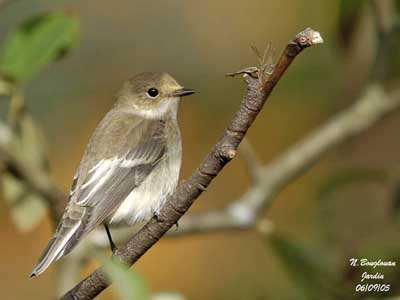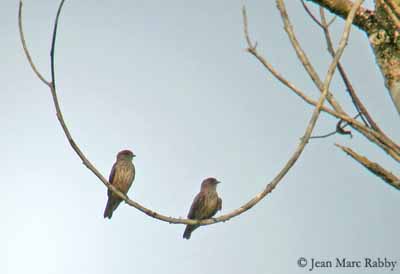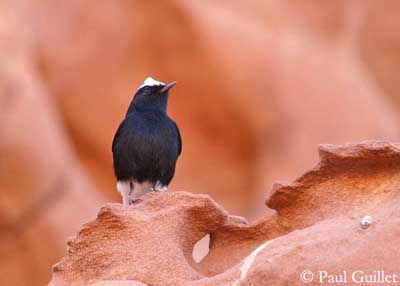
FAMILY MUSCICAPIDAE
Scrub Robins, Robin Chats, Forktails, Flycatchers, Bluethroats, Rock Thrushes, Robins, Redstarts, Magpie-Robins, Bush Chats, Stonechats and Wheatears
Recently, several species formerly classified in the Family Turdidae changed and are now included in the Muscicapidae.
Similar behaviours and genetic studies are the main causes of this new taxonomy.
They belong to the Old World species, and are distributed in Europe, Africa and Asia.
The birds of this family are rather small with species ranging from 10 to 22 cm long, and 4/8 to 25/42 grams in weight. They have short bill with wide base and small hook at tip, well adapted for catching insects of all sizes in flight.
Wings are more or less long and pointed, according to the migratory behaviour of each bird, and its feeding habits.
The plumage varies widely within this family, from dull colours (brown or grey), through black and white plumages, to bright coloured species, mainly found in Asia.
Like numerous birds’ species, the Muscicapidae are threatened by habitat loss due to fragmentation, deforestation, clearing of forests and human developments. However, many species are able to adapt and exploit modified habitats, and even to colonize artificial areas such as plantations, parks and garden or cultivated fields.
Text by Nicole Bouglouan
Photographers:
Aurélien Audevard
OUESSANT DIGISCOPING
José Luís Beamonte
Pájaros de España
Didier Buysse
Vision d’Oiseaux
Nicole Bouglouan
PHOTOGRAPHIC RAMBLE
Steve Garvie
RAINBIRDER Photo galleries
Paul Guillet
Photos d’Oiseaux
Niraj V. Mistry
Photo Galleries
Jean Marc Rabby
Des Ailes et des Plumes
Callie de Wet
GALLERY
Sources:
HANDBOOK OF THE BIRDS OF THE WORLD Vol 10 by Josep del Hoyo-Andrew Elliott-David Christie - Lynx Edicions - ISBN: 8487334725
HANDBOOK OF THE BIRDS OF THE WORLD Vol 11 by Josep del Hoyo, Andrew Elliott and David Christie - Lynx Edicions - ISBN: 849655306X
THE HANDBOOK OF BIRD IDENTIFICATION FOR EUROPE AND THE WESTERN PALEARCTIC by Mark Beaman, Steve Madge - C.Helm - ISBN: 0713639601
L’ENCYCLOPEDIE MONDIALE DES OISEAUX - Dr Christopher M. Perrins - BORDAS - ISBN: 2040185607


Female is usually duller than male, brown and white, and immature is typically similar to her while juvenile have spotted plumage. This feature is shared with the Turdidae.



Muscicapa striata
The members of this family are mainly arboreal species, and frequent wooded and bushy areas, open arid areas with scattered small trees, dry thornscrub, woodlands of various types, primary evergreen forests, swamp-forest and mangroves, but also plantations, parks and gardens, and cultivated fields.
This type of wooded habitat provides perches for hunting. The Muscicapidae perform sallies from perches after flying preys, and forages on branches and among vegetation and foliage.
They often build their nest in trees or among the branches of bushes, or in hollows in tree trunks.

Tickell’s Blue Flycatcher
Cyornis tickelliae
African species frequent drier habitats, shrubby savannahs, bushlands and grassy plains with scattered trees. The larger Marico Flycatcher occurs in acacia savannahs.

Marico Flycatcher -
Bradornis mariquensis
Genus Ficedula has very large range, from Europe to Africa and in Asia. These species breed in the well-wooded forested habitats.

Ficedula hypoleuca
During the migrations and after the breeding season, numerous species occur in wider variety of habitats. The Yellow-rumped Flycatcher (Ficedula zanthopygia) frequents mangroves, while the Narcissus Flycatcher (Ficedula narcissina) breeds in the undergrowth and ranges to the limit of the treeline (Russia) and the subalpine evergreen zone (Japan).


Muscicapidae are insectivorous, and stay long periods on exposed perch, waiting for flying preys. They perform rapid sallies to catch them. They often are alone or in pairs, even in small family groups, and numerous species join mixed foraging flocks. The birds gleaning among the vegetation are quiet and more secretive. But some species may be conspicuous by their behaviour, being very active and always moving, or calling.
The Afrotropical region’s species Melaenormis and Bradornis, are mainly ground feeders, and frequently hunt from perches or other structures.



Most Muscicapidae forage by day, but many flycatchers in Europe and Asia are also active and hawk insects at the end of the day, well into dusk. The Spotted Flycatcher (Muscicapa striata) feeds after dark on insects attracted to the streetlamps.
Adults and nestling flycatchers regularly regurgitate pellets of indigestible parts. The Spotted Flycatcher may produce one to six pellets per day.
Many flycatchers flick the wings and jerk the tail in several situations. These movements are used as contact between mates, but also during aggressive displays or when the birds are foraging, in order to disturb the preys and to catch them easily. Such movements may be advertising signals to locate each others and maintain some distance between them.
Anxiety behaviour towards intruders is usually similar, and bill-snapping may be added in some situations such as territorial displays and aggressive behaviour.
The Cassin’s Flycatcher (Muscicapa cassini) adopts first an upright posture before a pre-flight horizontal posture. If alarmed, it flicks its tail and the closed wings with quick jerky movements. Then, it drops the wing tips andgives alarm calls.

Cassin’s Flycatcher
Muscicapa cassini
These birds are not usually aggressive, but several species chase the predators away from the nest-site, by mobbing the intruders, even raptors. The Northern Black Flycatcher (Melaenornis edolioides) mobs snakes such as cobras using an aggressive fluttering flight, calling and bill snapping.

Northern Black Flycatcher
Melaenornis edolioides
The breeding behaviour of the Muscicapidae seems to be a monogamous mating system for most species, however, some of them are polygamous, and others are probably co-operative breeders.
The Sooty Flycatcher (Muscicapa infuscata) has been observed with stable trios of adults including a pair and one adult more (breeding or non-breeding bird, or young of at least two years). In this case, the nest is built by the female(s), but all adults feed the chicks.

Sooty Flycatcher
Muscicapa infuscate

The breeding period is closely associated with availability of invertebrates and according to the rainy seasons in equatorial ranges where the birds breed twice annually during the rains, or during the short dry season between the rainy periods.
Breeding behaviour including pair formation, courtship and mating is well known for African and European species.
The Spotted Flycatcher sings actively and displays at suitable nest-site, in order to attract a female. The male adopts crouched posture with fluffed crown and throat feathers, and then, bows and moves the head in all directions, flicks the tail and shuffles around.
Courtship behaviour often involves feeding of the female by the male and also during the incubation.
The Semicollared Flycatcher (Ficedula semitorquata) feeds the female only at nest. She adopts a crouching posture and the male mounts and copulates without any preliminaries. After mating, it perches close to her and sways the head from side to side.

Semicollared Flycatcher
Ficedula semitorquata
The nest is usually an open cup, domed in few species. It is often placed in trees, holes in trunks of large branches. Spotted, European Pied and Collared Flycatchers favour this type of nests.

Ficedula hypoleuca
The cup is on top of tree stump or in a fork, usually in dense foliage.
The Narcissus Flycatcher’s nest is behind peeling bark, or in piles of cut branches.


Other species nest in thick vegetation, in mount of dead twigs, in creepers attached to stump or rock, in crevices or cliff ledges, in walls or in the shelter of boulders on the ground, and sometimes under the overhang of streambanks. Height is very variable, from ground-level up to 2, 6, 15 and 22 metres above the ground.
The nests are typically built by females, and made with twigs, small sticks, moss, dead leaves, plant fibres, rootlets, grass, pine needles and lichen, and finer materials for the lining such as feathers or plant down as in Cassin’s Flycatcher.

Cassin’s Flycatcher
Muscicapa cassini
Clutch size is usually 2-3 eggs in tropical and subtropical species, up to 7 or 10 in species which breed in temperate regions. Both sexes seem to share the incubation, except in Ficedula and Muscicapa species where female incubates alone, during 11-15 to 17-18 days. The longest periods are observed in Spotted and European Pied Flycatchers and some others.
Nestlings are altricial and fed by both parents. Fledging period is usually the same as incubation period.

Muscicapa striata
The nest-defence is well developed. The European Pied Flycatcher attacks nest-predators by swooping-dives and calls. The larger intruders are mobbed away from the nest.

Ficedula hypoleuca
Muscicapidae have not well developed vocalizations, but if several species are mostly silent outside the breeding season, the permanently territorial species sing all year round. The sounds are rather weak, a common mixture of trills, rattles and squeaks, and buzzy, twittering or churring notes.
However, some species such as the Red-breasted Flycatcher (Ficedula parva) have complex, richer and more melodious song with loud, melodious, silvery advertising notes and made of several phrases with often individual variations.

Ficedula parva
These birds are primarily insectivorous, and the flycatchers that breed in temperate regions are largely migratory, whereas those of the tropical areas tend to be sedentary.
The Palearctic flycatchers are long-distance migrants and winter in the tropics. Many African species are sedentary and only perform local movements. The flycatchers of mainland Asia which breed in the Himalayas make altitudinal movements and reach lower elevation in winter.
Nomadism, seasonal and dispersive movements are recorded according to the range.
Finally, it is necessary to talk about the species coming from the Family Turdidae and now included in the Muscicapidae.
The subfamily “saxicolinae” shows numerous morphological adaptations including upright posture, some short or long-tailed forms and broad-based bill with dense rictal bristles used for aerial flycatching. Others have narrow bill and few bristles adapted for gleaning from substrates.
Except for the bright coloured species with show bright breast patches or underparts, or opposition of black and white in several others, the plumages often are subtle, adapted to understorey habitats.
Other species such as wheatears are terrestrial chats, and most of them are living in open, rocky or arid areas and do not favour wooded landscapes.



White-tailed Rubythroat
Luscinia pectoralis
European Stonechats (Saxicola rubicola) flick their wings when alighting as advertising signal, thanks to the flashing white wing-coverts.
Aggressive postures emphasize the most coloured parts of the body. The European Robin (Erithacus rubecula) adopts an upright posture in order to display the red patch of the breast in front of intruders, rivals or females.


Their feeding behaviour is almost similar, but differences occur in birds hunting also on the ground by hopping, running and walking. They perform less aerial behaviour than flycatchers, but are able to pursue flying insects.

Oenanthe oenanthe
Breeding behaviours are not so different, and according to the species, the birds nest in trees, cliff ledges, holes in trees, on the ground under roots or between rocks. The nestlings are altricial and fed by both parents. Adults defend and care them together.
The Blue Rock Thrush (Monticola solitarius) nests in rocky ledges in cliffs, and the Common Redstart favours cavities in monuments or walls.


As in Muscicapidae, some species migrate and others perform dispersions or altitudinal and seasonal movements.
But the main difference is the song. These birds have melodious and beautiful clear songs uttered during the breeding season, and at dawn and dusk. The most beautiful song is that of the Common Nightingale (Luscinia megarhynchos. When males arrive on the breeding areas in spring, they sing at night, and mainly in the middle of the night. Its song is powerful, rich and varied, often mentioned as the finest sound produced by any bird species.

Luscinia megarhynchos